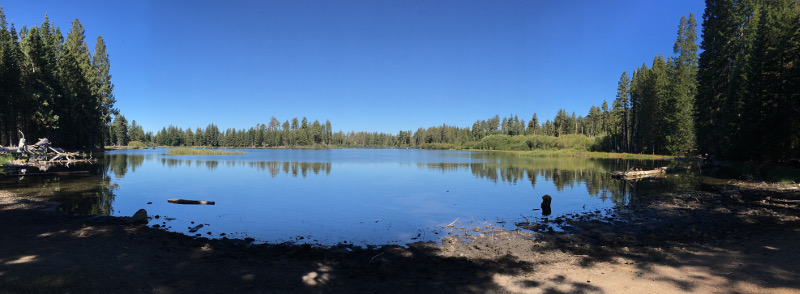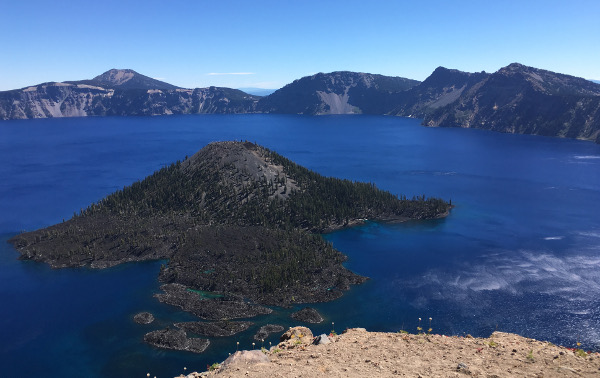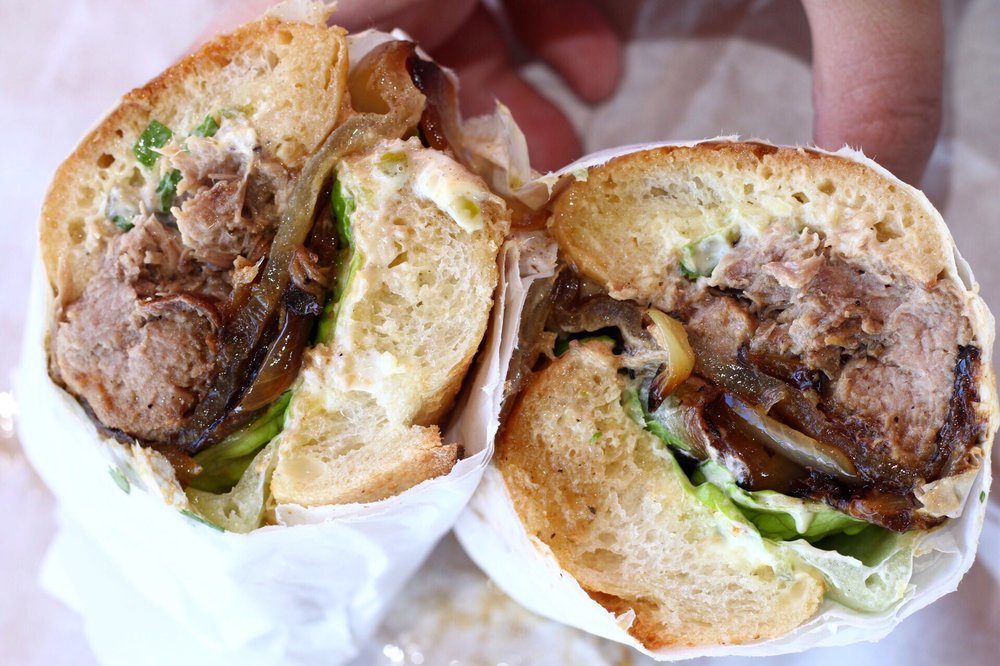
We started from Northern California, and visited Lassen Volcanic National Park, Crater Lake, Columbia Gorge, Washington Pacific shore, Washington State Capitol, and arrived at Seattle in the end. It was a long drive. We were tired at the end and yet wished the trip was longer.
Day 1: Getting to Redding
It was the drive day. We left around noon and reached Redding around dinner time. The hotel front-desk recommended a local Mexican restaurant that was cozy, delicious, and satisfying.
Day 2: Lassen Volcanic National Park
Lassen is about an hour away from Redding. We entered from the North entrance, hiked around Manzanita Lake (pictured), stopped by few places to hike or just walk-about. After about 3 hours, we traversed the same route back to Redding. Had we stayed at Red Bluff, we could have entered from the south, exited from north, and passed through Redding for the next stop.

In less than 30 minutes from Redding, we came to Shasta Lake (really a dam). We lingered around for about 45 minutes and continue to Mt. Shasta City and straight to the City Park where we were surprised with a local picnic concert. Dinner was at the picnic tables listening to a local rock band with beer in-hand. Probably a hundred or so reveled around us or just lazed in the lawn with their dogs. Carefree kids (and young adults) were running bare-foot, some with ice-cream in-hand. We did not really see the mountain at the park, but it was a good stop.
About 90 minutes later, we arrived at Klamath Falls, OR, to stay for the night.
Day 3: Crater Lake

This was the main attraction of the trip. The goal was to circle the lake. I budgeted 4 hours for this 35-mile loop. We arrived at the south entrance at 9am, and went counter-clockwise. The first stop was Pinnacle Peak. It was a easy stroll for the scene that seemed alien to this world. We came back to Plaikni Falls for an easy 2-mile hike along the well-paved trail. Afterward, we pretty much just drove along the rim roads and stopped at whatever Kodak points seemed interesting. The Phantom Ship and Watchman’s Point were clearly the must-sees. The rest were simply different view points of this magnificent lake.
Were I able to stay at Crater Lake Lodge, I would have made this a full-day stay for a couple of longer hikes. Campers will find very good facilities with firewood already split and staked near-by.
Even at 1:30pm, the nice restaurant at the Lodge had a 1-hour wait. We went to the Rim Cafe for a quick bite and went on to Columbia Gorge.
We pulled into Columbia Gorge Hotel around 7:30pm hoping for a nice dinner with a view. But the sun has already set too much. The dinner was very enjoyable. We went back to The Dalles to stay the night.
A supposedly light day ended up activity-packed. This Gorge is really a historical and cultural area. Expect rich local culture and activities surrounded by the grand expanse of river and gorge views.
We lingered at the Columbia Gorge Discovery Center for a couple of hours, even strolled to the back side to have a look at the river. Next, we ventured on several stops along the Fruit Loop near Hood River. Mt. Hood Winery sold us several bottles of their own Pinot Noir (both red and white!). Apple Valley Country Store provided us with fruits and pies.
For lunch, we ate at the famous Full Sail Brewery. Good beers, good foods!
We then drove along the historical Route 30 and stopped by several waterfalls. The largest one is Multnomah Falls which offered a good hike up to the head. Those falls invited us to linger around. At the end, we stopped by the windy Vista House and enjoyed the panorama view of the gorge.

At around 3:30pm, we headed to Astoria, skipping Portland. There was heavy traffic along the road, so we arrived at Cannery Pier Hotel around 7pm for a brief stop. Driving through the Astoria-Megler Bridge was a thrilling experience. There was this steep down-slope stretch that felt like you are diving into the water from mid-air.
Around 7:30pm, we reached our resting place in Long Beach, WA. Adrift Hotel has a nice restaurant on the 4th floor, Pickled Fish. We ate while watching the sun sinking below the ocean.
Day 5: WA State Capitol

The morning began with a nice stroll along the famed beach then we went for a very big breakfast at Laurie’s. After a quick fish-n-chip at Aberdeen, we went straight to Olympia where I peeked into the Senate’s chamber and found no session. The Capitol Garden had this sunken garden with Dahlia in full bloom and many more flowers.
The trip ended with a dinner at Ding Tai Fung, we were both hungry and tired and glad to be sleeping in our own beds, first time in 5 days.













 Finally, the third and final book is here. You may start now. Get all three and brew a nice pot of coffee. It is about a girl who saved the world.
Finally, the third and final book is here. You may start now. Get all three and brew a nice pot of coffee. It is about a girl who saved the world. The #1 on the menu and best seller — Caribbean Roast (Pork shoulder coated in marinade and slow-roasted until it falls into succulent morsels) — was indeed delicious. The meat was tender and flavorful. The baguette bread toasted lightly to provide the texture, structure, and the absorption for the juice, the sauces intense and flowing, the condiments (onion, veggie) added the extra dimension. It was an elbow-dripping messy and oh-so satisfying sandwich experienced.
The #1 on the menu and best seller — Caribbean Roast (Pork shoulder coated in marinade and slow-roasted until it falls into succulent morsels) — was indeed delicious. The meat was tender and flavorful. The baguette bread toasted lightly to provide the texture, structure, and the absorption for the juice, the sauces intense and flowing, the condiments (onion, veggie) added the extra dimension. It was an elbow-dripping messy and oh-so satisfying sandwich experienced. The also famous Fire-Roasted Corn featured small-kerneled corn that really served as the vehicle for the insanely unhealthy and delicious aioli. I finished it pretty much in 1 minute.
The also famous Fire-Roasted Corn featured small-kerneled corn that really served as the vehicle for the insanely unhealthy and delicious aioli. I finished it pretty much in 1 minute.